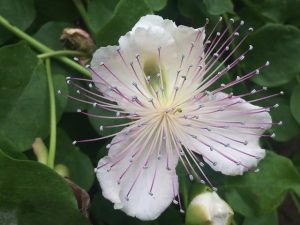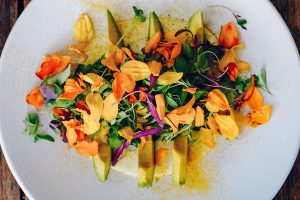We all know that much of our food comes from plants. Some of those plants are entirely edible while others provide food from specific parts. For example: we eat the roots of carrots and turnips; celery and asparagus are the stems of plants; leaves, such as lettuce, spinach, basil, and rosemary, are a source of much food; and we eat the fruits of many plants. Did you know the flowers of some plants can also be a food source?

Some commonly available foods, to which we often refer as vegetables, are actually the flowering buds of plants. Broccoli, cauliflower, artichokes, and capers are all immature flowers harvested prior to opening for use as food. If not harvested, cauliflower and broccoli would continue to mature and bloom with bright yellow flowers. Artichokes produce beautiful, feathery, purple flowers. The fragrant flowers of the caper bush have white petals and long pale purple stamens.
More Than Just A Pretty Face
You may be surprised how many edible flowers are already growing in your own ornamental or vegetable garden. I plant primarily for pollinators. Most of my plants, annuals and perennials, are considered ornamentals and most are chosen to provide food and shelter for pollinators in all seasons. But many of the flowers from my plants are more than just beneficial for bees and pretty to look at – they are also safe to eat.

For example, the flowers of chrysanthemum, lavender, or mint can be added to tea (chilled or hot) both for flavor and appearance. Wild violets, rose petals or buds, and lemon verbena can be frozen into ice cubes for drinks. Many, many flowers can be used in salad, including Dianthus (pinks), rosemary flowers, calendula, nasturtium, and the flowers of some beans and peas. Summer and winter squash blossoms can be eaten in salad or breaded, stuffed, and fried.
For an excellent resource, read Choosing and Using Edible Flowers. In this publication, the North Carolina State Extension provides a comprehensive listing of edible flowers. In addition to helpful information about growing and harvesting, it includes the potential use and flavor of each flower. It also explains how to avoid eating or serving a flower that is dangerous:
“Eat flowers only if you are certain they are edible. Avoid flowers that have been exposed to pathogens like those found in untreated manure. Flowers purchased from a florist, garden center, or nursery should be specifically labeled as edible; otherwise, they may have been treated with ornamental pesticides that are unsafe for use on food crops. Make certain that any pesticides used were approved for plants that will be consumed and that the application instructions have been followed carefully.”
Don’t Overlook “Weeds” But Proceed with Caution
Some plants we consider weeds can also be used as food. For example, the entire dandelion plant is edible and cultivated for medicinal properties in some countries. Tender spring leaves can be used in salads. The flowers are used to make dandelion wine. The roots, when roasted, can be used for dandelion tea or dried and used as a replacement for coffee.
Even the wild violet, the bane of my gardening life, is edible. Both leaves and flowers can be used in salads. The flowers, candied or fresh, make desserts beautiful and can be used in iced drinks.
Don’t eat any plant until you’re sure of its identify and that reliable authorities have determined it’s safe to eat! For help in identifying weeds and wildlings, try the Digital Atlas of the Virginia Flora.
Beware!
Not all flowers are edible and some parts of plants with edible flowers should not be eaten. Before eating that beautiful blossom, be absolutely sure it is safe for humans. If you are unsure, consult a reliable reference source such as the one provided by Poison Control. See also The Socrates Project: Poisonous Plants in Virginia and its helpful photos, published by the University of Virginia in 2020.
Also, even though a flower is edible, all parts may not be tasty. The white base of many flower petals is often bitter. Generally, you should remove stamens and pistils which carry pollen and may affect the flavor.
Try to harvest flowers at their peak, avoiding those that are not yet open or past prime. Be sure the plants are pesticide free and always wash thoroughly. Do not collect and eat plants from the roadside.
Information in this article is provided for educational purposes only. The inclusion of plants described as edible does not constitute an endorsement for foraging or consumption. Always verify plant identification using trusted resources, such as local Extension publications and Digital Atlas of the Virginia Flora, and consult credible experienced local foraging community groups before eating any plant material.
And Finally…
Explore your garden and consider which flowers might add taste, color, texture, or fragrance to the dinner table as more than decoration. You might be surprised at what dandelions bring to your salad plate.
SOURCES:
Featured Photo: Idéalités, CC BY-SA 4.0
“Edible Flowers” University of Minnesota Extension
“Do You Know Which Part of the Plant You’re Eating?” Brooklyn Botanic Garden
“Choosing and Using Edible Flowers” NC State Extension
“Poisonous Plants” Poison Control
“Capers, Capparis spinosa” Wisconsin Horticulture, Division of Extension